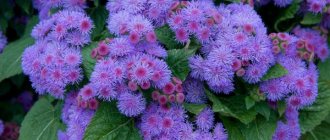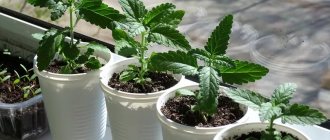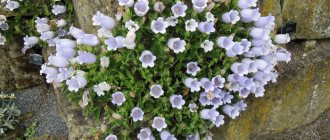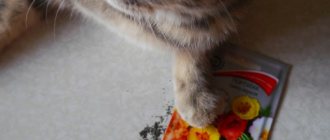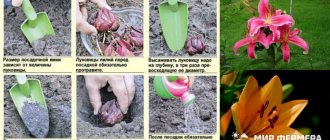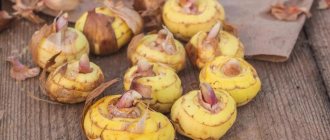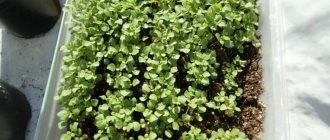Ageratum is a flowering plant from the Asteraceae family. Under natural conditions, it grows in the eastern part of India, North and Central America. “Ageratos” translated from Greek means “ageless.” This is due to the peculiarity of cut flowers not to wither for a long time.
In the 19th century, ageratum came to Europe, and since then has been widely cultivated by flower growers. The plant is loved by many for its spectacular fluffy inflorescences, reminiscent of pompoms, which are painted in different shades. Ageratum can become a decoration for any flower bed and garden plot. It is easy to care for and reproduces well using seeds.
Ageratum: types and varieties for open ground
About 60 types of crops grow in nature. Shrubs are tall (about 60 cm in height), medium tall (up to 30 cm), and dwarf (10-15 cm). But only some types of ageratum and their varieties are cultivated.
Blue or Blue Mink
Low branched shrub up to 25 cm in height. The inflorescences are lush, soft blue, reminiscent of mink fur. The diameter of the inflorescences is 5-8 cm.
Mexican or Houston
Compact spherical bush. Its height can vary between 10-60 cm, depending on the variety. The leaves are diamond-shaped or oval and may have jagged edges. The flowers are small, collected in small inflorescences-baskets.
Popular varieties of Mexican ageratum:
- Alba,
- Azur Pearl,
- Faye Pink,
- Blue Mink,
- Blue Bouquet,
- Blausternchen.
Growing from seeds to seedlings
Although ageratum is considered a perennial, in temperate climates it is grown as an annual and replanted every year. The best way to propagate a plant is by seed. From one bush you can collect up to 10 thousand seeds. They can be sown directly on the site or grown as seedlings. The best time to plant seeds for seedlings is the second half of March. But if you want to shift the flowering time, you can sow later.
Soil and container
For sowing, prepare shallow containers or boxes with drainage holes. Fill them with a mixture of equal parts of peat, sand and humus. The soil should first be disinfected with a solution of potassium permanganate and moistened.
Ageratum seeds are very small. To make it more convenient to sow them, it is recommended to mix them with sand. Distribute over the surface of the soil, press lightly. Spray with water using a spray bottle. Cover the top of the container with film or glass to avoid excessive evaporation of moisture. From time to time the cover must be removed to ventilate and moisten the soil.
Seedling care
For normal development of seedlings, it is necessary to keep them at a temperature of +20-25°C. Before germination, humidity should be at least 90%. Lighting does not play a fundamental role for seed germination. From the moment the gatherings appear, the shelter must be removed.
At the stage of opening the cotyledons and growing roots, it is important to keep the soil moist at all times. But you can’t flood the crops. When the shoots appear, they need to be provided with good lighting. After 3 weeks, the plant should already have 3 true leaves. Before planting on the site, seedlings need to be hardened off.
Picking
You can plant seedlings after the first pair of leaves appear. It is important not to delay this. If the plants are not planted in time, their roots will become intertwined and some of the seedlings will simply die. The first picking is carried out in the same box, planting the plants at a greater distance from each other. The seedlings are planted again after 2 weeks into separate cups or pots.
If you plant the seeds in separate peat pots, picking can be avoided.
Transplanting
The timing of planting seedlings in open ground may vary depending on the climate and region. In mid-latitudes, this can be done from mid-May, if the weather is finally warm outside and the soil is well warmed up.
Choose a well-lit area for planting seedlings.
Dig holes for the required number of plants. If the ageratum is tall, then the distance between the holes should be 20-30 cm; for low-growing varieties, 15 cm is enough. Water the holes and let it soak. Transfer the seedlings into them along with a lump of earth. The planting depth should be the same as it was in the pot. Warning! Under no circumstances should you fertilize the soil with manure. This can lead to the death of the culture.
Answers on questions
Ageratum is a very popular plant that is used to decorate balconies, loggias and landscapes. The plant is quite unpretentious in care and propagation, however, novice gardeners often have various questions.
What soil to buy for growing seedlings
In general, ageratum seedlings are not demanding on the soil, the main thing is that its acidity is neutral. A special flower soil or universal soil will do. When purchasing soil, you should always pay attention to:
- Package quality. A conscientious manufacturer always pays attention to the external design of the packaging;
- Information on the package. There should be detailed instructions, as well as information about the manufacturer;
- Availability of barcode. It should be located directly on the packaging itself, and not glued to a separate piece of paper.
You should not purchase soil if the package does not indicate its detailed composition and instructions for its use. Otherwise, the risk of destroying seedlings due to poor-quality soil increases.
How to plant ageratum in peat tablets
Peat tablets are a very convenient thing; if you plant seeds in them, then you will not have problems with replanting later. To do this, you need to do the following steps:
- Take a tray and place the tablets in it, making sure that the indentations point upward;
- Then pour in warm water, but make sure that the water is sufficiently infused;
- After the moisture has been completely absorbed, take tweezers and place the seeds and press lightly.
Then simply cover the tablet with film and transfer it to a warm place.
How to stimulate seeds for further growth
To stimulate growth, you can treat the seeds with a solution of a growth stimulant, then the sprouts will sprout together and faster.
Why don't the seeds germinate?
There can be many reasons for non-germination, for example, mistakes were made when transporting the seeds and they were damaged. It may also be that you placed the soil with the seeds in a room with a low temperature.
Why are seeds soaked?
Soaking seeds can make them more viable, and soaking increases their chances of germination.
What to do if ageratum seedlings do not grow
If the seedlings have stopped growing, then it is worth trying fertilizers, or better yet, adding stimulating fertilizing.
What plants are combined with ageratum in landscape design?
The culture gets along well with calendula, marigolds, zinnia and alyssum. This is especially true for shrubs with blue and lilac buds. In addition, verbena, begonia, petunia and aster are used in landscape design.
Gardeners fell in love with ageratum for its abundant and long-lasting flowering. It begins two months after germination and continues until the first frost. The main thing is to choose the right time for planting and carefully care for the plant.
How to harden ageratum seedlings
Hardening allows you to “accustom” seedlings to live in conditions of constant temperature changes. It is carried out gradually. The first hardening begins on the 3rd day after pecking of the flower crop. On the first day, leave the container open for a couple of hours, then for a day, then remove the film. Two-week-old seedlings can be taken out for a day into a greenhouse or another room where the temperature reaches +15-17°. On warm days, you can ventilate the premises, but do not allow drafts when growing.
Planting seeds in open ground
Ageratum can be sown directly on the site, if the climate permits. But flowering in such cases will occur later than with the seedling method of growing the crop.
Sowing time
The plant can be sown on the site when warm weather has completely established itself and there is no risk of night frosts. In temperate latitudes it is better to do this in mid-May. At first, it is still recommended to cover the area with crops at night with agrofibre if there is a significant difference between day and night temperatures.
Choice of location and lighting
The main requirement of ageratum for normal development is bright lighting. The flower can retain its decorative appearance only in sunny areas. Even a slight shadow leads to stretching of the stems, smaller leaves, and less lush flowering.
Therefore, the plant should be planted only in sunny areas, no matter whether it is a border, a border or a garden pot.
Priming
Ageratum has no special requirements for soil. Only very rocky and damp soil is not suitable for it. It is preferable to plant the plant in a nutrient substrate with neutral acidity. It must not be oversaturated with humus. This will encourage green growth and will have a negative effect on flowering.
Landing rules
Prepare the area in advance. Remove all weeds and dig up the soil. If its acidity is high, you can add lime. Make shallow furrows and sow seeds mixed with sand in them (for more uniform sowing). Sprinkle a thin layer of soil on top and water it. To make seedlings appear faster, it is better to create greenhouse conditions for the crops and cover them with polyethylene. When the shoots appear, they need to be thinned out. After a pair of true leaves appear, plant the seedlings at a longer distance from each other.
The best conditions for growth
Growing ageratum is not a difficult task; to do this, it is enough to create optimal conditions for the flower:
| Temperature | Watering | Lighting | Top dressing | Growth terms |
| 15-20 degrees | Moderate, using settled warm water | Bright and diffuse | 10 days after emergence, a mineral composition is added (for example, Fertika, Pokon, Raduga) | 60-65 days |
If you strictly follow all the recommendations, then after two months you can enjoy the lush flowering of ageratum in the flowerbed.
Outdoor care
There are no particular difficulties when growing ageratum. It is enough to provide basic care, as for other flowering plants.
Watering
The bush will be more lush if it is watered regularly. The soil should always remain evenly moist. But you should not allow water to stagnate in the hole. This can cause the plant's roots to rot. After watering, the soil under the ageratum needs to be loosened.
Feeding and fertilizer
During the entire growing season, the crop is fertilized 3 times. It is better to use complex mineral fertilizers for flowering plants. The dosage should be taken 2 times less than indicated in the instructions. Excess minerals will stimulate the growth of green mass, and the flowers will be small and inconspicuous. Organic fertilizers have the same effect. Therefore, it is better to avoid them.
Trimming and pinching
Ageratum needs to pick off faded inflorescences. This stimulates the formation of new flowers. Even if the bush is cut by more than half, in a short time it will restore its decorative properties. You can pinch the shoots of the plant even during the flowering period. Pinching is done over the top 3-4 leaves. You can form a beautiful bush according to your taste.
Weeding
A mandatory step in proper ageratum care is regular weed removal. If you do not get rid of them, they will take nutrients from the soil and interfere with the normal development of the flower. Weeds are especially harmful to low-growing species. During weeding, it is necessary to loosen the soil to provide air access to the roots.
Characteristic
Ageratum (planting and care, photos provide a complete description of a flower plant that can be planted in an open area to create a landscape interior) is mainly cultivated in tropical countries, namely in South America and Mexico.
The plant is found in eastern India. Since the crop does not tolerate severe frosts, in Russia the flower is cultivated as an annual plant. The flower is considered heat-loving; it can be grown for several years at home or in greenhouse conditions.
The plant has a strong root system, so Ageratum quickly adapts to a new area. The culture is a small shrub with shoots, the height of which does not exceed 60 cm. The plant is covered with small green foliage.
Flowers with shoots and foliage are covered with soft fibers, giving Ageratum a decorative appearance. Lilac and blue inflorescences have a tubular shape and are located in the bushy part. The petals resemble soft and long needles. Ageratum is characterized by long flowering, which lasts for 5 months. The process begins in May and ends in October.
During the flowering period, the bush is covered with lilac, white or pink flowers.
The plant is often used to create a landscape interior, since the flower harmoniously combines with other garden crops. It can be used to decorate carpet paths.
The photo shows different varieties of ageratum.
The flower has a huge number of varieties that have their own characteristics:
- "Blue Mink" It is considered the most popular variety. It has large flowers that are colored in a rich purple hue. Based on this variety, a huge number of hybrids have been created, which are characterized by small sizes.
- "Mexican". The height of the plant is approximately 50 cm. It is divided into herbaceous and shrubby species. In corymbose-shaped inflorescences there are flowers of a bluish tint with a purple tint. The variety is light-loving, adapts normally to sunlight and is not afraid of elevated temperatures.
- "Summer Snow" The shrub is miniature and not very branched. The plant is covered with small, light green leaves. Light flowers are collected in umbrella-shaped shields. The foliage is densely distributed over the entire surface of the bush. The flowering stage begins in June and lasts until the end of the autumn season. The variety is resistant to sultry heat. The plant is mainly planted in flowerpots or flower beds.
- "Pink Ball". It is considered an annual species of shrub with low branching. At the flowering stage, the plant is covered with fluffy pinkish flowers that have a fragrant aroma. The crop blooms from June to October. The leaf blade is pubescent and quite large. The variety prefers to be cultivated in nutritious soil. The Ageratum variety is used to decorate flower beds.
- "Bonjour". It is an annual low shrub, the height of which reaches approximately 25 cm. The flowering period begins in June and continues until the first cold weather. The inflorescences are characterized by their large size and corymbose shape. They contain flowers of various colors with a fragrant scent. Despite the fact that the culture is light-loving, it can be planted in a shady place. The variety is drought-resistant, suitable for mixed borders, ridges, flower beds and balconies.
- "Blanket of Snow" During the flowering period, the shrub is covered with snow-white flowers. They gather in paniculate and fluffy inflorescences. The plant is low-growing and spreading, reaching a length of approximately 25 cm. Suitable for creating flower beds.
- "White Ball". A low-growing, spherical bush covered with small light flowers. The variety can be cultivated on any soil and can withstand drought and semi-shaded areas. The flowering period lasts until frost. The shrub often decorates rocky hills, borders, balconies and flower beds.
- "Treasures of the Aztecs." The variety is propagated using seedlings. The flowering stage begins in summer and ends with the arrival of frost. The variety is suitable for growing in flowerpots, flower beds and borders.
Protection from pests and diseases
Although ageratum is unpretentious, it can be susceptible to various diseases. With excess moisture and cold air, it is affected by root rot. There is no point in fighting her. Affected plants are dug up and removed to prevent the disease from spreading further.
The flower can also be affected by cucumber mosaic. The shoots become glassy, and yellow spots appear on the leaf blades. The buds do not bloom. Diseased areas of the plant must be removed. And treat the remaining ones with a fungicide or a decoction of tansy and wormwood.
Common ageratum pests:
- spider mite;
- nematode;
- whitefly
You can destroy parasites using insecticides:
- Intavir;
- Aktara;
- Karbofos.
Preparing for sowing
Before starting sowing, it is important to carry out work to prepare the seed material, soil and planting containers.
Seed selection
Sowing seedlings can be done either with purchased seeds or with seeds collected from the site. Reliable manufacturers always place their contact details and necessary information on the packaging:
- time of seed collection and expiration date;
- recommendations on the time of sowing, planting in the ground and flowering;
- characteristics of the variety.
When sowing self-collected seeds, you should remember that they should be stored in paper or linen bags, and their shelf life is 3 to 4 years.
Preparing seeds for sowing
In order to disinfect and increase germination, planting material is subjected to pre-sowing treatment. Fungicides are used for disinfection: Fitosporin, Fundazol, Vitaros, Baktofit; to stimulate growth: Zircon, Epin-Extra, Energen. All procedures are carried out in strict accordance with the instructions for the drugs used.
Soil selection and treatment
Ageratum is quite unpretentious; any universal flower soil of neutral acidity is suitable for growing seedlings. To increase its air and water permeability, loosening elements (sand, vermiculite, perlite) are added in a ratio of 4:1. You can also prepare the soil mixture yourself: mix equal parts of garden soil, peat and sand.
Sowing soil, especially prepared independently, must be disinfected. The soil mixture is spilled with a pink-red solution of potassium permanganate or calcined for half an hour in the oven at 70°C.
Treatment of disinfected soil with Fitosporin (2 ml of solution per 1 liter of water) allows it to be populated with beneficial microorganisms Bacillus subtilis and increase fertility.
Selection of capacity
Sowing ageratum seeds for seedlings is carried out both in a common container with subsequent picking, and in individual containers (cups, pots, peat tablets and cassettes), which avoids this procedure.
The container for group planting should be shallow (7-10 cm) and have drainage holes. If the seed container is reused, it must be disinfected with a soda solution (1 tablespoon per 0.5 liter of water) or a dark pink solution of potassium permanganate.
